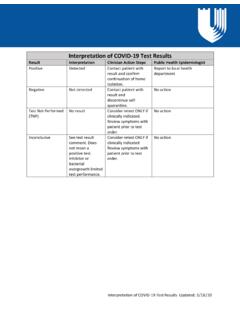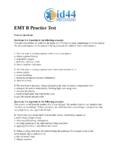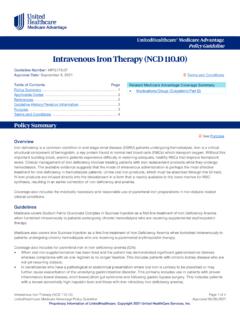Transcription of Respiratory Therapy Practices During the COVID-19 Pandemic
1 Respiratory Therapy Practices During the COVID-19 Pandemic Date: 05/07/2020. Background: This document is intended to guide the safe delivery of Respiratory therapeutics During the time of COVID-19 . Clusters of hospital-acquired Respiratory viral infections transmitted via aerosol droplets in the setting of delivering Respiratory therapeutics have been described. These outbreak investigations highlighted the following findings as etiologies: 1) open wards with multiple patient beds in close proximity; 2) lack of appropriate PPE. The physical space in which care is delivered throughout Duke Health is such that we are capable of placing patients in single rooms, mitigating the risk of infection transmission in open wards with multiple patients. In addition, the DUHS Infection Prevention team developed our PPE recommendations based on CDC and WHO guidance for the care of patients with suspected or confirmed COVID-19 and chose the highest level of Respiratory protection ( use of N95 respirator or PAPR over a surgical mask) for the care of patients with suspected or confirmed COVID-19 .
2 PPE Guidance: The Infection Prevention and Respiratory Therapy teams have worked closely together to develop guidance to ensure the appropriate infection prevention mitigation strategies are put in place to keep our staff and patients safe while delivering patient care. The following documents provide written and pictorial guidance for PPE use for DUHS providers and staff: Guidance for HCW PPE During COVID-19 Response Infographic: Appropriate PPE During COVID-19 Response As outlined in the above documents, Duke Health currently recommends that providers wear N95 and face shield or PAPR, gown, gloves, and shoe covers when caring for patients with suspected or confirmed COVID-19 . In addition, it is recommended that all patients wear masks when not in their room or During transport. Placing a mask on a patient provides source control by containing Respiratory secretions.
3 Since delivery of a variety of Respiratory therapeutics has the potential to create short range droplet-aerosols, all healthcare providers either administering these treatments or providing care in the room while a patient receives these treatments should be outfitted with appropriate PPE. Instructions for when reuse of an N95 versus using a new N95 During high- and low-risk aerosol generating procedures are outlined on page 3 of this document: N95s and Face Shields: Instructions for Extended Use and Reuse. Update: 5/7/20. Environmental controls: PPE provides the first line of protection against transmission of covid - 19 to health care providers and hospital staff. In addition, negative room pressure and HEPA. filtration help decrease environmental contamination in the room by removing aerosols from the air. For more details, please see COVID-19 Recommendations for Negative Pressure Rooms and/or HEPA filtration.
4 At Duke Health, the following environmental controls help to reduce risk of nosocomial transmission of COVID-19 to providers, staff, and other patients: Placing the patient in a single room Preferentially placing a patient in a negative pressure room, when available, should the need to perform aerosol generating procedures or therapies Placing a HEPA filter in a patient's room, if negative pressure rooms are not available, should the need to perform aerosol generating procedures or therapies Respiratory Therapy Treatments and Infection Control Measures: The following section describes methods to safely manage Respiratory Therapy treatments. Bacterio-viral filters o For patients with suspected or confirmed COVID-19 bacterio-viral filters should be used while administering Respiratory Therapy . o Heat moisture exchanges (HME) are not rated as viral filters.
5 O The look of filters may change as substitutions are utilized in order to keep stock at appropriate levels. Please be sure to check the device to assure it is a filter and not an HME. o The adult HME with 6 inches of heat-sealed corrugated tubing is both an HME. and a filter. o The grey filter does not attach directly to the ETT without an adapter. Adult HME/Filter Pediatric/Neonatal HME/Filter Update: 5/7/20. Patient Transport: o Patient preparation: The nurse/direct caregiver will don all appropriate special airborne contact PPE and prepare the patient for transport. Within the room, place a face mask (procedure/surgical mask) on the patient to contain secretions During transport. o Ventilated patients: Ensure a viral filter is placed on the expiratory limb of the circuit. Place patient on portable ventilator for transport.
6 Ensure cuffed endotracheal tube cuffs are inflated to create a seal with the trachea to prevent inadvertent aerosol dispersion. Transport patients using a ventilator with an expiratory filter. If a manual resuscitator is needed, ensure a viral filter is placed between the endotracheal tube and the manual resuscitator. o High-flow oxygen (>4L). Place a face mask over the oxygen interface (cannula, mask, etc.) to contain secretions while the patient is traveling outside of the patient room. o Patients with a Tracheostomy: Ventilated patients: Place a T-piece with a filter on the expiratory portion of the T-piece. Place a T-piece with a filter on the expiratory portion of the T- piece. Trach collar: Cover the trach collar with a trach mask. o Non-invasive Ventilation (NIV): Avoid transporting patients on non-invasive ventilation, when possible.
7 If patients must be transported, place an expiratory filter on the circuit and place a face mask over the patient-NIV interface. o Changing devices: If the patient must be disconnected from one device to transfer to another, the endotracheal tube must already have a filter in place or be momentarily clamped to prevent aerosol dispersion. If transferring from a ventilator, ventilation should be stopped or paused prior to disconnecting the circuit and only initiated after the patient is placed back on a ventilator with a filter on the expiratory limb. If you have to disconnect from the ventilator at any time: Turn the current vent off or place in standby With the ETT clamped, kinked, or occluded with a gloved hand, transfer to the new device (or manual resuscitator). Update: 5/7/20. Note: If the ETT already has a bacterio-viral filter in place, occlusion is not necessary Initiate the new device only after the connection between the device and ETT is secure Update: 5/7/20.
8 Pictures of devices: Manual Resuscitation with bacterio-viral filter for transport (or any other bagging needs). Transport Ventilator (Vela) with bacterio-viral filter at exhalation port Update: 5/7/20. Transport Ventilator (babyPAC) with bacterio-viral filter at exhalation port Bacterio-viral filtration for mushroom-valve exhalation ( LTV, MRI vent). Update: 5/7/20. Oxygen Delivery: o Face masks on patients: Face masks are required to be placed over patients' oxygen delivery devices while a patient is outside of a closed room ( During transport). Face masks may be placed over high-flow nasal oxygen as one part of an infection prevention bundle to reduce the overall bioburden of covid in the environment of the patient only if the following conditions are met: The patient agrees to have the mask placed ( it is not causing distress).
9 Masks are only placed on the patients when providers must perform direct patient care activities that require a prolonged amount of time spent within 6 feet of the head of the bed ( not for other room entry to check IV pump, etc.). The mask is only applied while the provider(s) is/are in the room with the patient and is removed before leaving the room Providers should understand that there will be times when patients cannot be masked due to Respiratory distress/anxiety, who must be fed, or who need other assistance that would preclude masking and that performing these activities is still completely safe. The addition of the mask is just one additional measure in the infection prevention bundle and all providers who enter the room are already adequately protected by the PPE used for special airborne contact precautions.
10 O Low flow oxygen, such as that at 4L/min and below does not need to be automatically humidified. o Trach oxygenation: For Standard Trach Tube: Connect a Venturi adaptation (like used for transport) to a T-piece with 6-inch reservoir with bacterio-viral filter at exhalation point. For Laryngectomy Tubes or Stoma: If having compromise and increased oxygen needs, place an appropriately-sized trach or endotracheal tube **Always consult with a physician when manipulating an airway Update: 5/7/20. o Non-invasive Ventilation Therapy Non-invasive masks should be used in conjunction with a bacterio-viral filter. The anti-asphyxiation valve will remain closed unless airflow ceases or the circuit is obstructed. Home CPAP prongs and nasal interfaces may be used in conjunction with a bacterio-viral filter on dry home circuits. Humidified circuits may overload the filter causing increased resistance to airflow.









